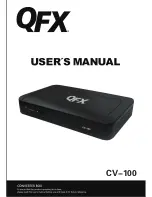
WAVECOM Decoder W74PC, W-PCI/e, W-CODE, W-CLOUD Manual V9.1.0
Transmission Modes
237
C5 - presentation code - 2 digits - type of alphabet used
The National Geospatial-Intelligence Agency (NGA) maintains the Safety NET Users Handbook on the In-
marsat Homepage, and is available at no charge (http://www.inmarsat.com/Maritimesafety/snet.pdf).
Receiving Broadcasts
Most Inmarsat C terminals will not receive a safety broadcast if it is transmitting a message, or if it is
tuned to an Inmarsat ocean region not used for safety broadcasts in the area travelled. Most Safety NET
messages are rebroadcast after 6 minutes, to give a transmitting terminal time to receive missed messag-
es. Lists of Safety NET broadcast schedules and areas have been published by the JOINT WMO/IOC COM-
MISSION FOR OCEANOGRAPHY AND MARINE METEOROLOGY to assist ship operators tune Inmarsat C
terminals to the proper Inmarsat ocean region.
Although reception of Safety NET traffic is automatic, the shipboard operator must set up the receiver
properly at the start of the voyage:
Select the appropriate broadcast channel. This can often be accomplished by logging on to a land
earth station in the ocean region for which needed broadcasts are made.
Select the NAVAREA identification code.
If travelling near Australia, select the proper coastal area codes.
Ensure the Inmarsat C station is connected to a working navigational receiver. If a connection
cannot be made, the ship's position must be manually updated every four hours during the ship's
voyage. Without these updates, reams of unnecessary broadcast messages will be received.
Broadcast Channel Information
The modulation rate of the broadcast channel is 1200 Baud. Forward error correction is applied to this,
creating an effective information transfer of 600 bits per second (rate 1/2 convolutional coding with inter-
leaving is used to disperse error bursts which arise when deep fades are present). This ensures that there
is a high probability of receiving a message correctly at the first transmission, irrespective of the atmos-
pheric conditions or the ship's position within the satellite coverage.
Inmarsat Utilities
A copy of the latest version of the “Safety NET Users Manual” is available from the Inmarsat web site,
www.inmarsat.com/Maritimesafety/snet.pdf. . The “Inmarsat Maritime Communications Handbook” is no
longer available from Inmarsat, but maz be donloaded from other Internet sites.
STATUS OF MARITIME SAFETY INFORMATION BROADCASTS
NAVAREA
NAV
MET
SAR
OCEAN REGION
METAREA
WARNINGS
FORECASTS & WARN-
INGS
ALERTS
FOR SCHEDULED BROAD-
CASTS
I (UK)
X
X
X
AOR-E
II (France)
X
X
X
AOR-E
III (Spain/Greece)
X
X
X
AOR-E
IV (USA)
X
X
X
AOR-W
V (Brazil)
X
X
X
AOR-E
VI (Argentina)
X
X
X
AOR-W
VII (South Africa)
X
X
X
AOR-E + IOR
VIII (India/Mauritius/La Reu-
nion)
X
X (Note 3)
X
IOR
IX (Pakistan)
X
X
X
IOR
X (Australia)
X
X
X
IOR + POR
XI (Japan/China)
X
X
X
IOR + POR
XII (USA)
X
X
X
POR + AOR-W















































